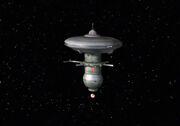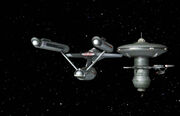(written from a Production point of view)

Starbase 6 in 2268
The dialogue from the Star Trek: The Original Series episode "The Ultimate Computer" simply refers to the starbase as "the space station," however, based on information obtained from Michael Okuda, the CGI model of the remastered edition was labeled as "Starbase 6", but that was not entirely visible on screen. It is unclear why this base number was chosen when it was previously associated with an unnamed planet in "The Immunity Syndrome".
Design

Starbase 6 in its original appearance

Okazaki's final design concept for starbase 47
In the original 1968 airing of "The Ultimate Computer", stock footage of Deep Space Station K-7 from "The Trouble with Tribbles" was re-utilized to represent the station. In the 2008 remastered edition of that episode, the design was revised based upon Masao Okazaki's design for Starbase 47 in the Star Trek: Vanguard series of novels from Pocket Books (though scaled down in size). Okazaki on his design:
"Editor Marco Palmieri (...) contacted me in the fall of 2004 asking me if I could design a space station for an upcoming series of paperback novels. He had seen my stubby "J-class" TOS-era space station design at my Star Trek Museum website and thought it could be adapted as the Vanguard space station. Although meeting the 1-month deadline was complicated by my full-time job as a editor and lecturer at a medical school, Marco's offer was one I could not refuse.
"Marco envisioned Vanguard as a 1-km-diameter station similar in function to the Earth Spacedock from Star Trek III: The Search for Spock but clearly reflecting the TOS aesthetic. It was to have an internal dock for 4 Constitution-class starships, living space for 1,000 people, cargo-handling areas, a power plant, life-support machinery, fabrication areas, and a communications array. I took my "J-class" design and doubled it in size to about 1.2 km in diameter. I flattened the "mushroom cap" for the internal dock, lengthened the stem, and added a large bulb at the end for engineering spaces and the subspace antenna.
"Both Marco and I liked my first pass, but he asked for a few more variants just to make sure; we ended up going with my first pass. With the exterior designed, I began blocking out the interior. I soon discovered that this station, although much smaller than Spacedock, still had a lot more space than we knew what to do with. Borrowing an idea from Franz Joseph, I suggested that the upper half of the mushroom cap be make into a park-like habitat, which was dubbed the terrestrial enclosure. Even with the mushroom cap mostly hollow, we still had too much space. I had visions of endless rooms and empty hallways, like the Overlook Hotel from The Shining. The cap originally had a 9-deck-thick slice of rooms, which had a volume equal to 35 Empire State Buildings. I took out most of these decks, enlarged the terrestrial enclosure, and left a ring of decks at the edge for lifeboats. shuttle bays, and luxury-box-like spaces.
"The spine of the station has various conduits for energy and life-support and a zero-gravity tube for cargo handling. As it passes through the terrestrial enclosure, I envisioned a gleaming, flood-lit Hugh Ferriss-style art-deco column ringed with upward blooming terraces and apartments. Marco told me, however, that the spine was always cloaked (damn!). Just before delivery, Marco still thought the station was too big, so I had to rush and shrink it a further 30%. That necessitated a frantic rescaling and redrawing of all the decks, but I was able to send Marco the eps files on time. (...)" [1](X)
CGI models

Doug Drexler's CGI Starbase 47 for Star Trek: Vanguard series

Close-up of Drexler's model
Two CGI models were eventually built of the starbase design. Once given the go-ahead by Pocket Books, Doug Drexler built and rendered a CGI version that eventually adorned the covers of several novels in the Vanguard series. "I dig Vanguard station because it looks appropriately old school, while embracing the design directions of the original feature films!", Drexler commented. [2](X) It was David Rossi of CBS Digital who hit upon the idea of using Okazaki's design for TOS remastered when he saw one of Drexler's covers. On Drexler's blog Okuda remembered:
"It was David Rossi's idea to use Vanguard Station as the basis for the station in the remastered version of "The Ultimate Computer". At one of our planning meetings, Dave showed us one of your [rem: Drexler's] beautiful book covers from one of the Vanguard novels. The next day, we got an OK from John Van Citters and Paula Block of CBS Consumer Products, and Margaret Clark and Marco Palmieri at Pocket Books to use the design. Masao Okazaki was also enthusiastically supportive. The actual digital model in the episode was built by a talented artist named Apollo Kim at CBS Digital, under the supervision of visual effects supervisor Niel Wray. They based it closely on your renderings, although it was somewhat simplified because we knew it would be relatively small in the frame. I was the one responsible for having the station re-scaled. For our particular shots in this episode, I didn't want the starbase to dwarf the USS Enterprise and the USS Lexington." [3](X)

CBS' CGI Starbase 6 for "The Ultimate Computer"
In a later interview, Okuda went into more detail about the CBS version. He elaborated:
"We had originally planned to re-use the K-7 model for the "The Ultimate Computer", just as in the original version of the episode. It was producer Dave Rossi who came in with one of Doug Drexler's book covers, showing Masao's wonderful design. We immediately contacted John Van Citters and Paula Block at CBS Consumer Products to ask for permission to use the design. Once they said "yes" (which didn't take long!), we asked Niel Wray, the visual effects supervisor at CBS Digital if it would be possible to add the new station at this relatively late point in the production cycle. Niel was excited about adding the station, but he was cautious because we really were coming down the wire in terms of schedule and budget, which were always tight anyway.
"The CBS Digital version of Masao's station was modeled by a talented artist named Apollo Kim (what a great name for someone working on Trek!), and animated by Eric Ehemann and Chris Barsamian. Other talented members of the CBS Digital crew who worked on the model station were digital texture painter Sun Chung, lighting technical director Brian Vogt, and compositor James Holt.
"They pretty much followed Doug's rendering of Masao's design, but I asked them to make a couple of tweaks. First, I asked them to reduce the overall scale of the station. In the original series, Gene was pretty clear that he wanted the Enterprise to be the biggest, most powerful ship in the fleet. Even though the station isn't a ship, I didn't want it to dwarf the Enterprise too much. The station just had to be big enough that you'd believe it could absorb the 400 members of the Enterprise crew.
"Also, I knew that we'd only see it briefly with the Lexington docked. I didn't want the Lexington to disappear in that quick shot, so I wanted to make the ship as large as possible with relationship to the station. Finally, I asked them to tweak the station's arms so that the edge of the Lexingtons saucer could dock directly with the station. Naturally, I was a little nervous about what Masao and Doug would think about what we'd done with their station, but fortunately, both said they liked it!" (Star Trek Magazine issue 162, p. 84).
